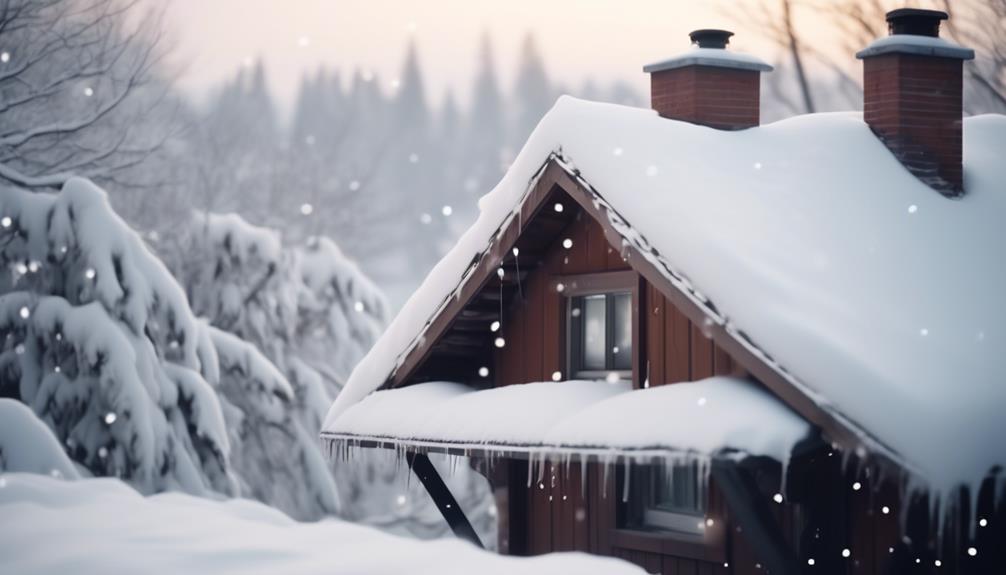As homeowners, we all know that winter can be as relentless as a snowstorm, and with it comes the risk of damage to our roofs. But fear not, for there are proven techniques that can snow-proof your roof and protect your home like a sturdy shield.
From inspecting weak spots to hiring professional snow removal, this discussion will shed light on the most effective strategies for safeguarding your roof against the weight and wrath of winter.
So, whether you're a seasoned snow warrior or a novice looking to fortify your home, join us as we explore these invaluable techniques that will keep you warm, dry, and worry-free during the winter months.
Inspect for Weak Spots
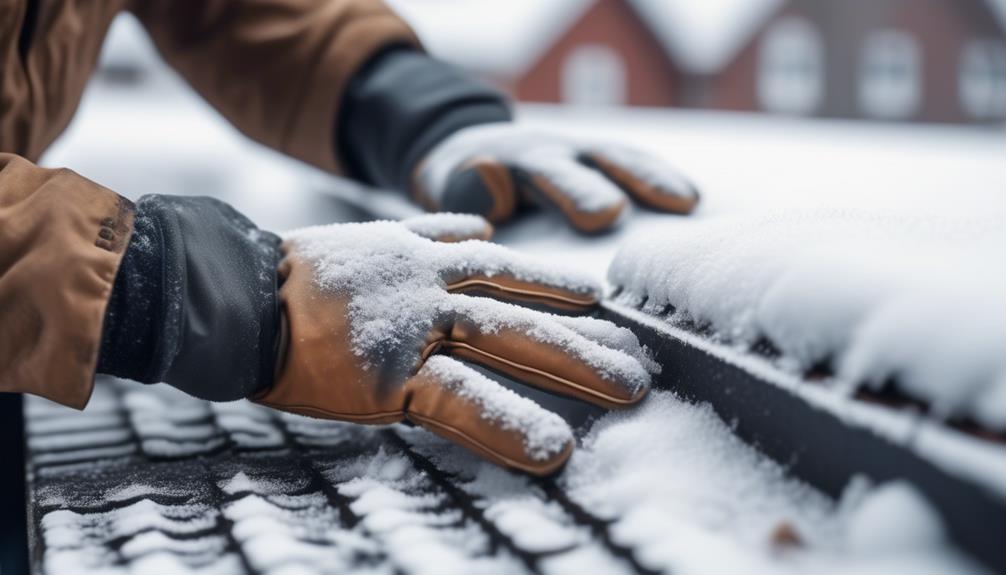
To effectively snow-proof your roof, we must first inspect for any potential weak spots. Weak spot detection is a crucial step in roof maintenance, as it allows us to identify areas that may be susceptible to damage or leaking under the weight of heavy snow. By thoroughly examining the roof, we can proactively address any issues and prevent costly repairs or replacements in the future.
During the inspection, we focus on several key areas. First, we check the condition of the shingles or roofing material. Any signs of cracking, curling, or missing pieces indicate vulnerability and should be addressed promptly. We also examine the flashing around chimneys, vents, and skylights, as these areas are prone to leaks. If we detect any loose or damaged flashing, we secure or replace it to ensure watertight protection.
Furthermore, we pay close attention to the gutters and downspouts. Clogged or damaged gutters can lead to water accumulation, which increases the weight on the roof during snowfall. By cleaning and repairing the gutters, we prevent potential ice damming and water infiltration.
Another crucial aspect of weak spot detection is inspecting the attic. We look for signs of water stains, mold growth, or insulation damage, as these issues can indicate roof leaks. Additionally, we ensure proper ventilation and insulation to prevent ice dams and excessive heat loss, which can contribute to snow accumulation and roof damage.
Clear Gutters and Downspouts
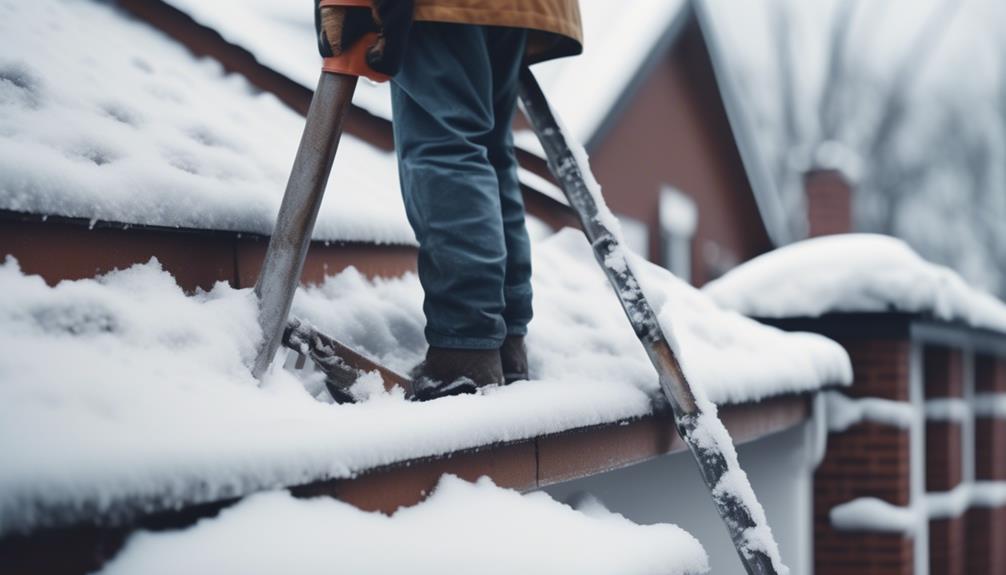
To ensure the snow-proofing of your roof is effective, it's essential to clear the gutters and downspouts. Neglecting this step can lead to clogged drainage systems, which in turn can cause water to back up and potentially damage your roof.
Here are some important tips for clearing your gutters and downspouts:
- Regular Maintenance: Make it a habit to clean your gutters and downspouts at least twice a year, once in the spring and once in the fall. This will help prevent leaves, debris, and other obstructions from clogging the system.
- Use Snow Removal Tools: When clearing your gutters and downspouts during the winter, it's important to use the right tools. A gutter scoop or a small trowel can effectively remove debris, while a hose with a high-pressure nozzle can help flush out any remaining dirt or blockages.
- Check for Leaks: While clearing your gutters and downspouts, take the opportunity to inspect for leaks. Look for any cracks or gaps in the system that could potentially cause water to seep into your home. Promptly address these issues to prevent further damage.
Preventing leaks and ensuring proper drainage is crucial for snow-proofing your roof. By regularly clearing your gutters and downspouts and using appropriate snow removal tools, you can maintain a reliable and efficient drainage system.
Install Snow Guards
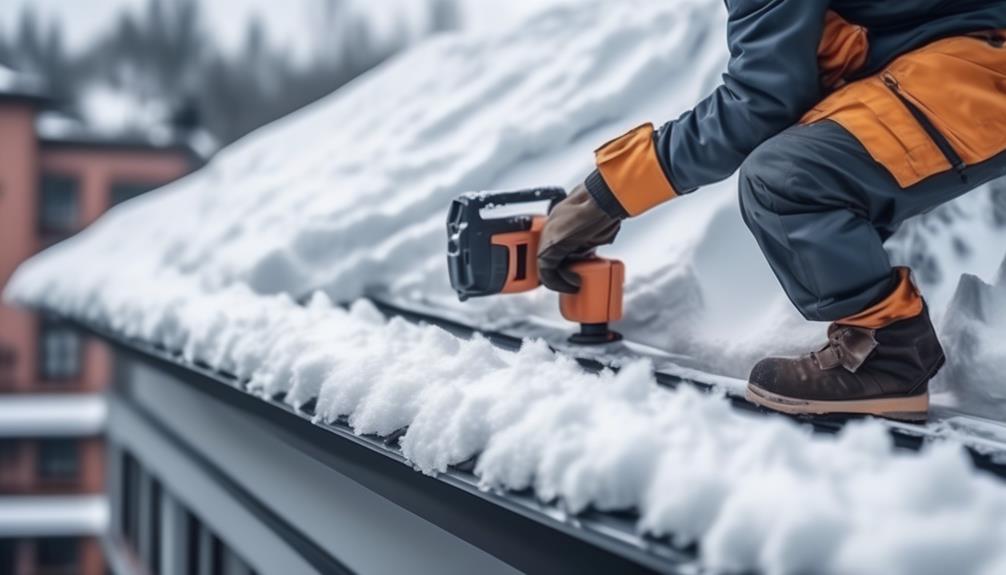
When it comes to snow-proofing your roof, one important step is to install snow guards. Snow guards provide several benefits, such as preventing snow and ice from sliding off your roof, protecting your gutters and downspouts, and reducing the risk of injury or property damage.
There are various types of snow guards available, including pad-style, pipe-style, and fence-style guards, each with their own advantages.
Proper installation techniques, such as spacing and placement, are crucial to ensure the effectiveness of snow guards in preventing snow accumulation and potential roof damage.
Benefits of Snow Guards
We highly recommend installing snow guards on your roof for several important reasons.
Snow guard installation is a crucial aspect of snow-proofing your roof.
Here are the benefits of using snow guards:
- Prevents snow slides: Snow guards help to prevent dangerous snow slides from sliding off your roof all at once, which can cause damage to property or even injure people below.
- Protects gutters: By holding the snow in place, snow guards prevent the buildup of heavy snow and ice in your gutters, which can lead to blockages and damage.
- Preserves the roof's integrity: Snow guard effectiveness ensures that the weight of accumulated snow is distributed evenly across the roof surface. This prevents excessive stress on the roof structure and helps extend its lifespan.
Installing snow guards is a wise investment that protects your property, reduces maintenance costs, and ensures the safety of both your roof and the people around it.
Types of Snow Guards
There are various types of snow guards available for installation on your roof to prevent dangerous snow slides and protect your property. Choosing the right type of snow guard is crucial to ensure its effectiveness and longevity. Different snow guard materials have distinct characteristics that determine their performance in different climates and roof types. Some common materials used for snow guards include metal, plastic, and rubber. Metal snow guards are durable and can withstand heavy snow loads. Plastic snow guards are lightweight and cost-effective, making them a popular choice. Rubber snow guards provide excellent grip and flexibility, making them suitable for roofs with a low pitch. In addition to selecting the appropriate material, proper snow guard spacing is essential to evenly distribute the weight of the snow and prevent ice dams. The table below summarizes the different types of snow guards and their key features.
| Snow Guard Material | Key Features |
|---|---|
| Metal | Durable, suitable for heavy snow loads |
| Plastic | Lightweight, cost-effective |
| Rubber | Excellent grip, flexible, ideal for low-pitch roofs |
Installation Tips and Tricks
To ensure a successful installation of snow guards on your roof, follow these practical tips and tricks:
- Choose the right type of snow guards: Selecting the appropriate snow guards for your roof is crucial. Consider factors such as roof pitch, snow load, and roof material to determine the best option.
- Proper placement is key: Installing snow guards in the right locations is essential to their effectiveness. Place them strategically where snow slides off the roof, such as valleys and eaves, to prevent snow accumulation and potential roof damage.
- Avoid common installation mistakes: Some common problems during snow guard installation include improper spacing, inadequate fastening, and using incorrect materials. Ensure that you follow the manufacturer's instructions precisely and use high-quality materials to avoid these issues.
Reinforce the Roof Structure
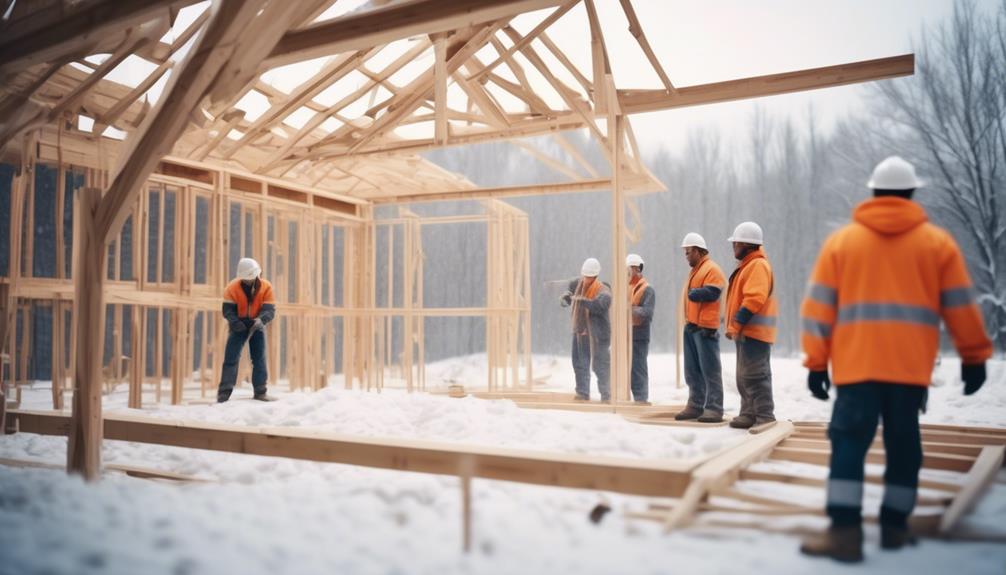
To reinforce the roof structure, consider adding additional support beams or trusses to enhance resilience and withstand the weight of heavy snow loads. Reinforcement techniques are crucial to maintaining the structural integrity of your roof and preventing potential damage caused by excessive snow accumulation. By taking proactive measures, you can ensure that your roof can handle the weight and stress of winter conditions.
One effective method of reinforcement is to install additional support beams. These beams provide extra strength and stability to the roof structure, distributing the load more evenly and reducing the risk of structural failure. Another option is to incorporate trusses into the roof design. Trusses are triangular structures that provide excellent support and can be customized to fit the specific needs of your roof. They help to distribute the weight of the snow more effectively, reducing the strain on individual components.
To give you a better understanding of the options available, here is a table comparing the features of support beams and trusses:
| Support Beams | Trusses |
|---|---|
| Provide extra strength and stability | Excellent support and load distribution |
| Can be added to existing roof structures | Customizable to fit specific roof needs |
| Distribute load more evenly | Reduce strain on individual components |
Improve Attic Insulation
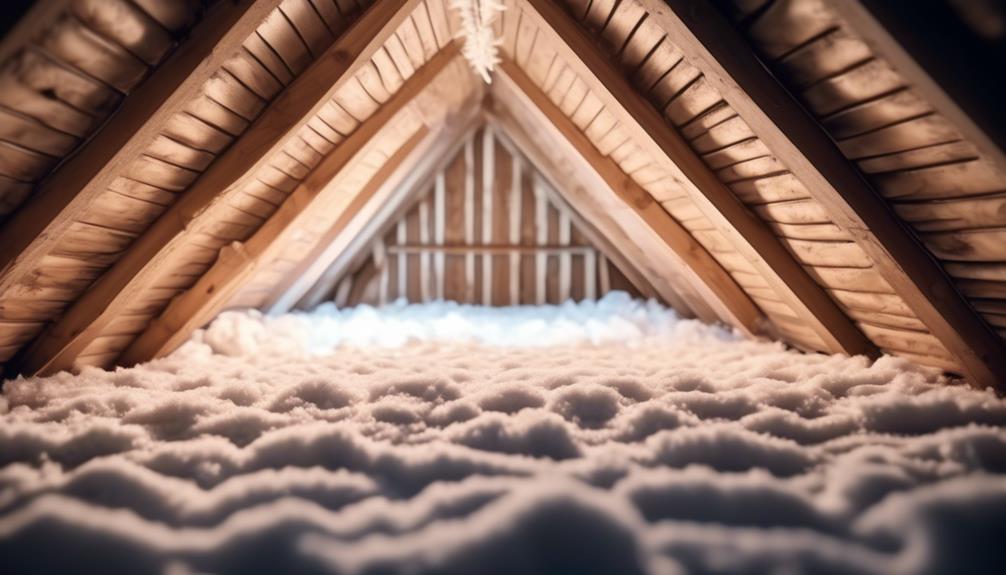
When reinforcing the roof structure to withstand heavy snow loads, it's essential to also consider improving the attic insulation. Proper insulation plays a crucial role in maintaining the integrity of your roof and ensuring energy efficiency in your home.
To effectively improve attic insulation, here are three key steps to follow:
- Evaluate the Existing Insulation: Start by assessing the current state of your attic insulation. Look for any signs of damage or wear, such as gaps, thinning areas, or moisture issues. Understanding the condition of your insulation will help you determine the necessary steps to improve it.
- Add Additional Insulation: If your attic has insufficient insulation, it's crucial to add more to achieve the desired energy efficiency. Consider using materials with high R-values, such as fiberglass or cellulose, to maximize insulation effectiveness. Install the insulation evenly throughout the attic, ensuring complete coverage and avoiding any gaps or spaces.
- Ensure Proper Ventilation: Along with insulation, proper attic ventilation is essential for maintaining a healthy roof structure. Adequate ventilation prevents the buildup of excess heat and moisture, which can lead to ice dams and structural damage. Install vents or fans to allow for air circulation and remove any potential moisture or humidity.
Improving attic insulation not only enhances the durability of your roof but also contributes to energy efficiency within your home. By properly insulating your attic and ensuring proper ventilation, you can reduce heat loss, lower energy bills, and create a more comfortable living environment.
Take the time to assess your attic, add insulation where needed, and ensure proper ventilation for a snow-proof and energy-efficient roof.
Ventilate the Attic Space
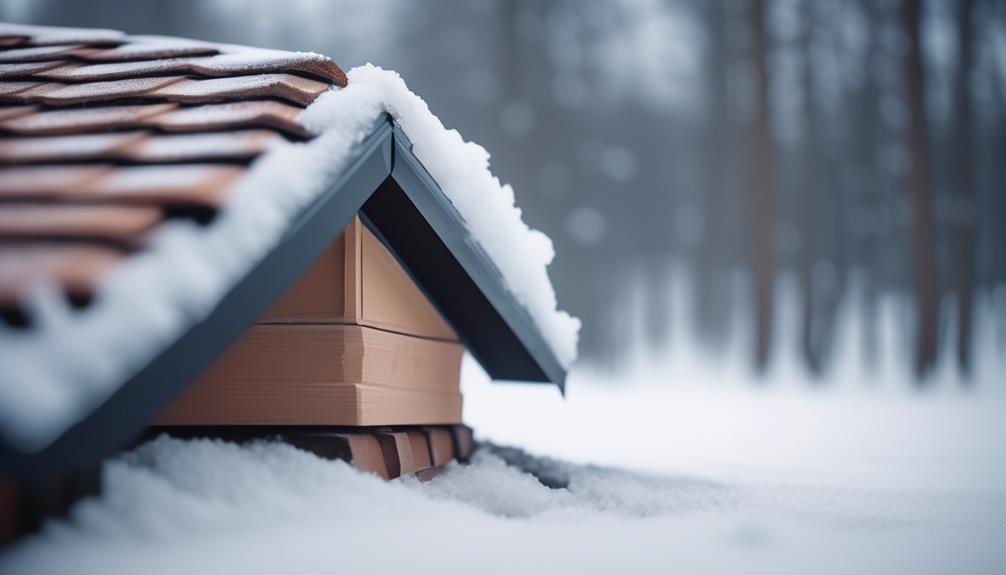
When it comes to snow-proofing your roof, proper insulation for ventilation is crucial.
We know from experience that a well-ventilated attic space allows for proper air circulation, helping to prevent the formation of ice dams.
Proper Insulation for Ventilation
For optimal ventilation and insulation in your attic space, it's crucial to ensure that proper measures are taken. Proper ventilation not only helps in maintaining the structural integrity of your roof but also helps in preventing the formation of ice dams and excessive condensation.
Here are three important techniques to achieve proper ventilation and insulation in your attic:
- Install roof vents: Roof vents allow for the escape of hot air, reducing the risk of moisture buildup and potential damage to your roof.
- Use soffit vents: Soffit vents are installed along the eaves of your roof to allow fresh air to enter the attic, promoting air circulation.
- Insulate properly: Ensure that your attic is properly insulated to prevent heat loss during winter and heat gain during summer, maintaining a comfortable temperature and reducing energy costs.
Importance of Air Circulation
Proper air circulation in the attic space is essential for maintaining the integrity of your roof and preventing issues such as moisture buildup and ice dams. In order to achieve optimal air circulation, it is important to ventilate the attic space effectively. This can be done through a combination of intake and exhaust vents, which allow fresh air to enter the attic and stale air to exit. By ensuring proper air circulation, you can improve the energy efficiency of your home and prevent roof leaks.
To help you understand the importance of air circulation in the attic space, here is a table outlining the benefits:
| Benefits of Proper Air Circulation in the Attic Space |
|---|
| Improves energy efficiency by reducing heat buildup |
| Prevents moisture buildup and condensation |
| Reduces the risk of ice dams and roof leaks |
| Extends the lifespan of your roof |
| Promotes a healthier living environment |
Preventing Ice Damming
To prevent ice damming, it's crucial to ensure proper ventilation in the attic space. Here are three key reasons why ventilating your attic can help prevent icicle formation and avoid the dangers of ice dams:
- Regulates Temperature: Adequate ventilation allows for proper airflow, preventing warm air from getting trapped in the attic. This helps to maintain a consistent temperature, reducing the likelihood of snow melting and refreezing on the roof.
- Reduces Moisture: Proper ventilation helps to remove excess moisture from the attic, preventing condensation and minimizing the risk of ice dams forming.
- Preserves Roof Integrity: By preventing ice dams, you can protect your roof from potential damage caused by the weight of the ice and water.
Trim Overhanging Tree Branches
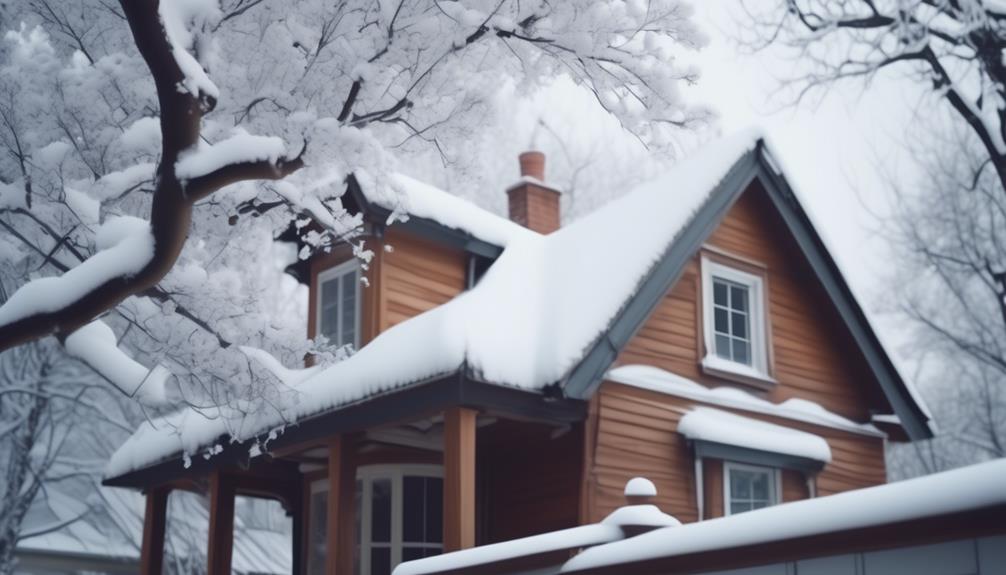
We recommend trimming overhanging tree branches to prevent potential damage to your roof during periods of heavy snowfall. Overhanging branches can pose a significant threat to the integrity of your roof, especially when laden with snow. By proactively addressing this issue through regular tree trimming, you can avoid costly repairs and ensure the long-term durability of your roof.
Here are three key reasons why tree trimming is essential for roof maintenance:
| Reasons to Trim Overhanging Tree Branches | Benefits | Action Steps |
|---|---|---|
| Prevents damage from falling branches | Avoids potential roof damage caused by heavy snowfall or storms | Regularly inspect trees near your property for overhanging branches and trim them appropriately to prevent potential hazards |
| Improves roof ventilation and sunlight exposure | Enhances the lifespan of your roof by reducing moisture buildup and preventing the growth of mold and algae | Trim branches that obstruct sunlight from reaching your roof, ensuring proper airflow and moisture control |
| Minimizes the risk of wildlife infestations | Reduces the likelihood of animals accessing your roof and causing damage to shingles and other roofing materials | Trim branches that provide easy access points for critters to reach your roof, keeping your property secure from unwanted visitors |
By maintaining a proactive tree trimming regimen, you can safeguard your roof against potential damage and extend its lifespan. Regular inspections, coupled with timely trimming, will help you identify and address any potential risks before they escalate into costly repairs or replacements.
Hire Professional Snow Removal
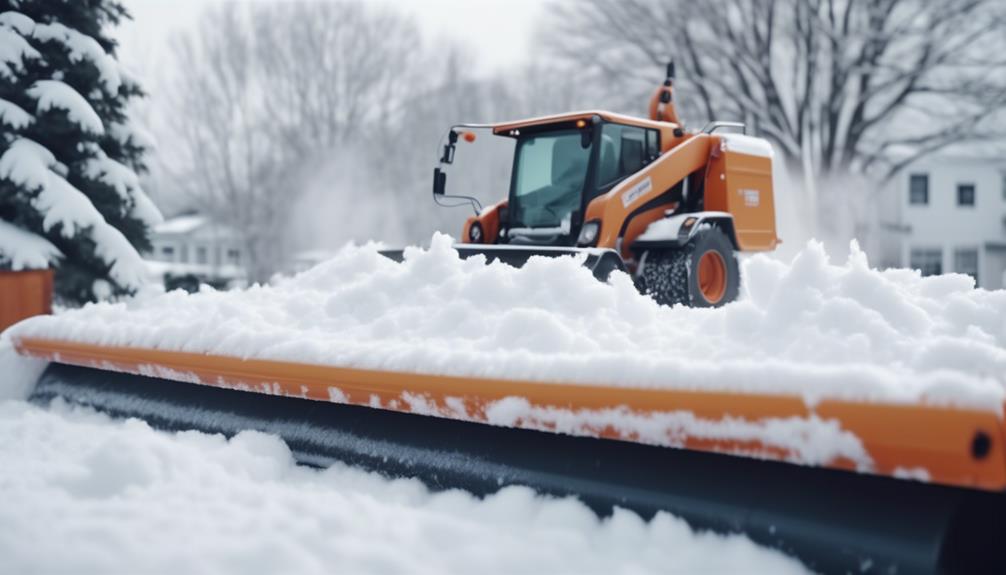
For optimal results and to ensure the safety of your property, it's highly recommended to hire professional snow removal services. Clearing snow from your roof isn't only time-consuming but also potentially dangerous. Professionals have the expertise and equipment to efficiently and safely remove snow, preventing any potential damage to your roof.
Here are the benefits of hiring professionals for snow removal:
- Experience: Professional snow removal companies have years of experience in handling different types of roofs and snow conditions. They know the best techniques and strategies to remove snow without causing any harm to your roof.
- Safety: Removing heavy snow from your roof can be a risky task. It requires climbing ladders, working at heights, and dealing with slippery surfaces. Professionals are trained in safety protocols and have the necessary equipment, such as safety harnesses and proper footwear, to ensure their own safety as well as the safety of your property.
- Preventative Maintenance: Regular maintenance is crucial for the longevity of your roof. By hiring professionals for snow removal, you can prevent ice dams, roof leaks, and other potential issues caused by the weight of snow. Regular snow removal can also help maintain the structural integrity of your roof and prevent costly repairs in the long run.
Hiring professionals for snow removal not only saves you time and effort but also ensures the safety and longevity of your roof. Their experience, safety measures, and regular maintenance practices make them the best choice for keeping your roof snow-proofed. So, leave the snow removal to the experts and enjoy a worry-free winter season.
Frequently Asked Questions
How Often Should I Inspect My Roof for Weak Spots?
When it comes to inspecting our roof for weak spots, we make it a regular practice. Identifying weak spots is crucial to ensuring the structural integrity of our roof.
We recommend inspecting your roof at least once a year, ideally before the snow season. Look out for signs of damage such as cracked, missing, or loose shingles.
Strengthen weak spots by replacing damaged shingles, reinforcing the underlying structure, and ensuring proper insulation. Regular inspections can help prevent costly repairs down the line.
What Are the Signs of Weak Spots on a Roof?
When it comes to roof maintenance and repair, we've seen it all. Weak spots on a roof can be sneaky little devils, but there are some telltale signs to watch out for.
Keep an eye out for cracked shingles, sagging areas, or water stains on your ceiling. These are red flags that your roof might need some attention.
Don't wait until it's too late – regular inspections and prompt repairs can save you a whole lot of headache (and money) in the long run.
Can I Clear My Gutters and Downspouts by Myself, or Should I Hire a Professional?
Clearing gutters and downspouts is a crucial task in maintaining a healthy roof.
We've found that it can be done by homeowners themselves, but it requires caution and proper equipment.
If you have experience and feel confident, go ahead and tackle it. However, if you're unsure or have a complex roof design, hiring a professional is the safer choice.
They have the expertise and tools to ensure a thorough and safe cleaning.
How Do Snow Guards Help Prevent Snow Damage to the Roof?
Snow guards are essential for preventing snow damage to your roof. They work by creating a barrier that holds the snow in place, preventing it from sliding off in large chunks. This is especially important in regions with heavy snowfall, as the weight of the snow can cause significant damage to your roof and gutters.
Snow guard installation is a crucial part of roof maintenance and should be done by professionals to ensure proper placement and effectiveness. Regular maintenance and the use of snow guards will help protect your roof from snow-related issues.
What Are the Benefits of Hiring a Professional Snow Removal Service?
Hiring a professional snow removal service offers numerous benefits.
Firstly, professionals have the expertise and experience to safely and effectively remove snow from your roof. This reduces the risk of damage to your roof and prevents potential leaks.
Additionally, hiring professionals is a cost-effective solution in the long run. They have the proper equipment and techniques to efficiently remove snow, saving you time and money on potential repairs.
